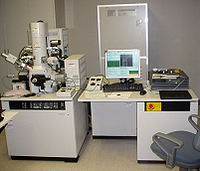Focused ion beam

Okay kiddo, let me explain to you what a focused ion beam is. Imagine you have a toy gun that shoots tiny, tiny particles called ions. These ions are like little bullets that can be aimed really precisely at something you want to cut or analyze. That's how a focused ion beam works: it's like a super-charged version of your toy gun that helps scientists look at things really closely.
With a focused ion beam, scientists can shoot ions at a tiny point on a material, like a piece of metal or even a living cell. The ions knock off pieces of the material, kind of like carving away a sculpture. But instead of using a chisel and hammer, they're using ions. This allows them to make really precise modifications to the material they're studying.
One cool thing about this technique is that scientists can use it to look at the inside of things without destroying them. Say you have a tiny computer chip that you need to inspect. You could use a focused ion beam to slice off a really thin layer of the chip and study it under a microscope. This helps scientists understand what's going on inside the chip without damaging it.
Another use for focused ion beams is in nanotechnology. Nanotechnology is all about making really, really small things—things that are too tiny to see with the naked eye. To make these tiny structures, scientists can use a focused ion beam to chisel away at a material until it's the size and shape they want. This allows them to make incredibly precise structures on a microscopic level.
So that's a focused ion beam in a nutshell. It's like a high-tech version of your toy gun, only instead of shooting foam darts, it shoots tiny ions that can help scientists look really closely at things and make really precise modifications to materials. Cool, huh?
With a focused ion beam, scientists can shoot ions at a tiny point on a material, like a piece of metal or even a living cell. The ions knock off pieces of the material, kind of like carving away a sculpture. But instead of using a chisel and hammer, they're using ions. This allows them to make really precise modifications to the material they're studying.
One cool thing about this technique is that scientists can use it to look at the inside of things without destroying them. Say you have a tiny computer chip that you need to inspect. You could use a focused ion beam to slice off a really thin layer of the chip and study it under a microscope. This helps scientists understand what's going on inside the chip without damaging it.
Another use for focused ion beams is in nanotechnology. Nanotechnology is all about making really, really small things—things that are too tiny to see with the naked eye. To make these tiny structures, scientists can use a focused ion beam to chisel away at a material until it's the size and shape they want. This allows them to make incredibly precise structures on a microscopic level.
So that's a focused ion beam in a nutshell. It's like a high-tech version of your toy gun, only instead of shooting foam darts, it shoots tiny ions that can help scientists look really closely at things and make really precise modifications to materials. Cool, huh?
Related topics others have asked about:
